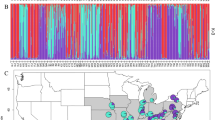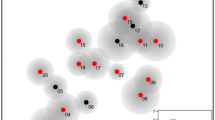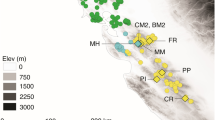Abstract
Maclura pomifera, an autotetraploid, and Gleditsia triacanthos, a diploid, are ecologically similar dioecious tree species that often co-occur in early succession habitats throughout the mid-western United States. We studied levels of genetic diversity and patterns of genetic structure for four polymorphic enzyme loci of M. pomifera and 16 polymorphic enzyme loci of G. triacanthos from a single population in eastern Kansas. Levels of expected heterozygosity were high for both species, averaging 0.725 for M. pomifera and 0,366 for G. triacanthos. Although genotypes for nearly all G. triacanthos loci were in Hardy-Weinberg frequencies, three of four M. pomifera loci deviated from equilibrium expectations. Two aspects of genetic structure were explored. First, the extent of clonal growth was estimated by comparing genotypes of stems within 50 G. triacanthos and 32 M. pomifera clumps. The great majority of clumps contained more than one genotype, and in many clumps, all stems were genetically unique. Secondly, as revealed by spatial autocorrelation analyses, genetic substructure was very local for both species, with significant positive autocorrelation occurring only within clumps of individuals or among near neighbours. We argue that this pattern of spatial structure for both species results from extremely local seed dispersal and establishment of individuals from the same multiseeded fruit.
Similar content being viewed by others
Article PDF
References
Bayer, R J. 1989. Patterns of isozyme variation in western North American Antenneria (Asteraceae: Inuleae) II. Diploid and polyploid species of section Alpinae. Am J Bot, 76, 679–691.
Bugbee, R E, and Riegel, A. 1945. Seasonal food choices of the fox squirrel in western Kansas. Kans Acad Sci Trans, 48, 199–203.
Dewey, S E, and Heywood, J S. 1988. Spatial genetic structure in a population of Psychotria nervosa. I. Distribution of genotypes. Evolution, 42, 834–838.
Dice, L R. 1945. Some winter foods of the cottontail in southern Michigan. J Mammal, 26, 87–88.
Epperson, B K. 1990a. Spatial patterns of genetic variation within plant populations. In; Brown, A. H. D., Clegg, M. T., Kahler, A. L. and Weir, B. S. (eds) Plant Population Genetics, Breeding, and Genetic Resources, Sinauer, Sunderland, Massachusetts, pp. 229–253.
Epperson, B K. 1990b. Spatial autocorrelation of genotypes under directional selection. Genetics, 124, 757–771.
Epperson, B K, and Clegg, M T. 1986. Spatial-autocorrelation analysis of flower color polymorphisms within sub-structured populations of morning glory (Ipomoea purpurea. Am Nat, 128, 840–858.
Fowells, H A. 1965. Silvics of Forest Trees of the United States. Agriculture Handbook No. 271. US Department of Agriculture, Washington, DC.
Friedman, S T, and Adams, W T. 1985. Estimation of gene flow into two seed orchards of loblolly pine (Pinus taeda L.). TheorAppl Genet, 69, 609–615.
Gabriel, K R, and Sokal, R R. 1969. A new statistical approach to geographic variation analysis. Syst Zool, 18, 259–278.
Gordon, D. 1966. A revision of the genus Gleditsia (Leguminosae). Ph.D Thesis, Indiana University, Champagne-Urbana.
Haldane, J B S. 1930. Theoretical genetics of autopolyploids. J Genet, 22, 359–372.
Hamrick, J L, and Godt, M J W. 1990. Allozyme diversity in plant species. In: Brown, A. H. D., Clegg, M. T., Kahler, A. L. and Weir, B. S. (eds) Plant Population Genetics, Breeding, and Genetic Resources, Sinauer, Sunderland, Massachusetts, pp. 44–64.
Hamrick, J L, and Holden, L R. 1979. Influence of micro-habitat heterogeneity on gene frequency distribution and gametic phase disequilibrium in Avena barbata. Evolution, 33, 521–533.
Hamrick, J L, Linhart, Y B, and Mitton, J B. 1979. Relationships between life history characteristics and electrophoretically detectable genetic variation in plants. Ann Rev Ecol Syst, 10, 173–200.
Harju, A, and Muona, O. 1989. Background pollination in Pinus sylvestris seed orchards. Scand J For Res, 4, 513–520.
Jain, S K, and Bradshaw, A D. 1966. Evolutionary divergence among adjacent plant populations. I. Evidence and its theoretical analysis. Heredity, 21, 407–441.
Laushman, R H, Schnabel, A, and Hamrick, J L. 1990. Electrophoretic Evidence for tetrasomic inheritance in the dioecious tree Maclura pomifera (Raf.) Schneid. Am J Bot, 77, 75 (abstract).
Levin, D A. 1983. Polyploidy and novelty in flowering plants. Am Nat, 122, 1–25.
Li, C C. 1976. First Course in Population Genetics. Boxwood Press, Pacific Grove, California.
Li, C C, and Horvitz, D G. 1953. Some methods of estimating the inbreeding coefficient. Am J Hum Genet, 5, 107–117.
Loveless, M D, and Hamrick, J L. 1984. Ecological determinants of genetic structure in plant populations. Ann Rev, Ecol Syst, 15, 65–95.
Mathwig, J E. 1971. Relationships betwween bruchid beetles (Amblycerus robinae) and honey locust trees (Gleditsia triacanthos). Ph.D Thesis, University of Kansas, Lawrence.
Milton, J B, Linhart, Y B, Hamrick, J L, and Beckman, J S. 1977. Observations on the genetic structure and mating system of ponderosa pine in the Colorado front range. Theor Appl Genet, 51, 5–13.
Nagasaka, K, and Szmidt, A E. 1985. Multilocus analysis of external pollen contamination of a Scots pine (Pinus sylvestris L.) seed orchard. In: Gregorius, H.-R. (ed.), Population Genetics in Forestry, Springer-Verlag, Berlin, pp. 134–138.
Ness, B D, Soltis, D E, and Soltis, P S. 1989. Autopolyploidy in Heuchera micrantha (Saxifragaceae). Am J Bot, 76, 614–626.
Oden, N L. 1984. Assessing the significance of a spatial correlogram. Geographical Analysis, 16, 1–16.
Peattie, D C. 1953. A Natural History of Western Trees. Houghton Mifflin, Boston, Massachusetts.
Rohlf, F J, and Schnell, G D. 1971. An investigation of the isolation by distance model. Am Nat, 105, 295–324.
Schnabel, A. 1988. Genetic structure and gene flow in Gleditsia triacanthos L. Ph.D Thesis, University of Kansas, Lawrence.
Schnabel, A, and Hamrick, J L. 1990. Organization of genetic diversity within and among populations of Gleditsia triacanthos (Leguminosae). Am J Bot, 11, 1060–1069.
Schoen, D J, and Latta, R G. 1989. Spatial autocorrelation of genotypes in populations of Impatiens pallida and Impatiens capensis. Heredity, 63, 181–189.
Smith, J L, and Perino, J V. 1981. Osage orange (Madura pomifera): History and economic uses. Econ Bot, 35, 24–41.
Sokal, R R, and Oden, N L. 1978. Spatial autocorrelation in biology 1. Methodology. Biol J Linn Soc, 10, 199–228.
Sokal, R R, Jacquez, G M, and Wooten, M C. 1989. Spatial autocorrelation analysis of migration and selection. Genetics, 121, 845–855.
Soltis, D E, and Soltis, P S. 1989. Genetic consequences of autopolyploidy in Tolmiea (Saxifragaceae). Evolution, 43, 586–594.
Soltis, D E, Haufler, C H, Darrow, D C, and Gastony, G J. 1983. Starch gel electrophoresis of ferns: a compilation of grinding buffers, gel and electrode buffers, and staining schedules. Am Fern J, 73, 9–27.
Stebbins, G L. 1980. Polyploidy in plants: unresolved problems and prospects. In: Lewis, W. H. (ed.), Polyploidy, Plenum, New York, pp. 495–520.
Turkington, R, and Harper, J L. 1979. The growth, distribution, and neighbour relationships of Trifolium repens in a permanent pasture. IV. Fine scale biotic differentiation. J Ecol, 67, 245–254.
Turner, M E, Stephens, J C, and Anderson, W W. 1982. Homozygosity and patch structure in plant populations as a result of nearest-neighbor pollination. Proc Natl Acad Sci USA, 79, 203–207.
Wolf, P G, Soltis, D E, and Soltis, P S. 1990. Chloroplast-DNA and allozymic variation in diploid and autotetraploid Heuchera grossulariifolia (Saxifragaceae). Am J Bot, 77, 232–244.
Wright, S. 1943. Isolation by distance. Genetics, 28, 114–138.
Zar, J H. 1974. Biostatistical Analysis. Prentice-Hall, Englewood Cliffs, N.J.
Acknowledgements
Acknowledgements This work was funded by NSF Doctoral Dissertation Improvement grant BSR-851447 to JLH for AS, a University of Kansas General Research grant to JLH, and a grant from Sigma Xi, The Scientific Research Society to RHL. John Heywood kindly supplied the computer program for autocorrelation analyses. We also thank an anonymous reviewer, who made several thoughtful suggestions for improving the manuscript.
Author information
Authors and Affiliations
Rights and permissions
About this article
Cite this article
Schnabel, A., Laushman, R. & Hamrick, J. Comparative genetic structure of two co-occurring tree species, Maclura pomifera (Moraceae) and Gleditsia triacanthos (Leguminosae). Heredity 67, 357–364 (1991). https://doi.org/10.1038/hdy.1991.99
Received:
Issue date:
DOI: https://doi.org/10.1038/hdy.1991.99
Keywords
This article is cited by
-
Stand development stages and recruitment patterns influence fine-scale spatial genetic structure in two Patagonian Nothofagus species
Annals of Forest Science (2022)
-
Genetic diversity in North American Cercis Canadensis reveals an ancient population bottleneck that originated after the last glacial maximum
Scientific Reports (2021)
-
Fine-scale spatial genetic structure of sycamore maple (Acer pseudoplatanus L.)
European Journal of Forest Research (2012)
-
Spatial genetic structure of two sympatric neotropical palms with contrasting life histories
Heredity (2005)
-
Allozyme variation and structure of the Canarian endemic palm tree Phoenix canariensis (Arecaceae): implications for conservation
Heredity (2004)



